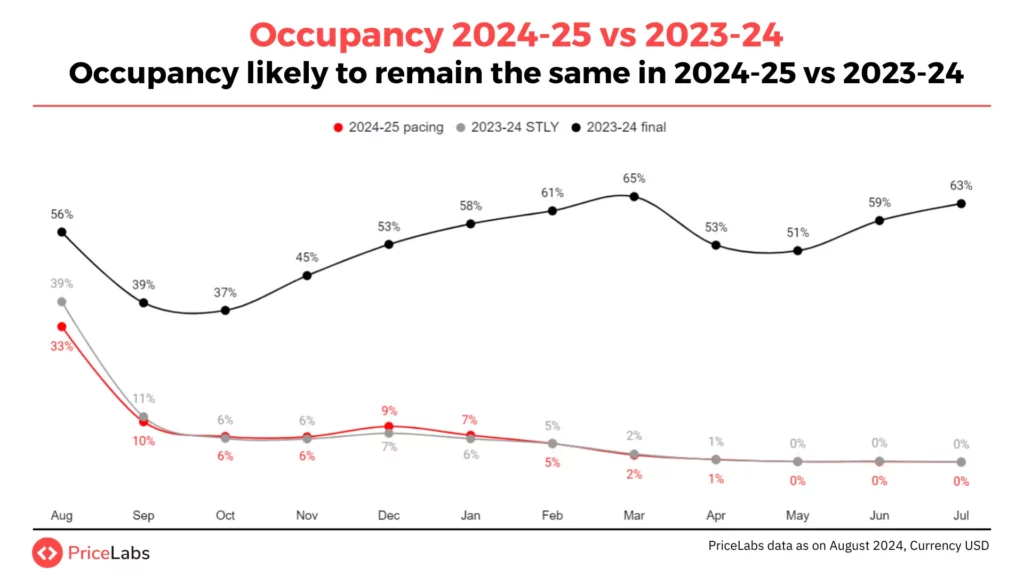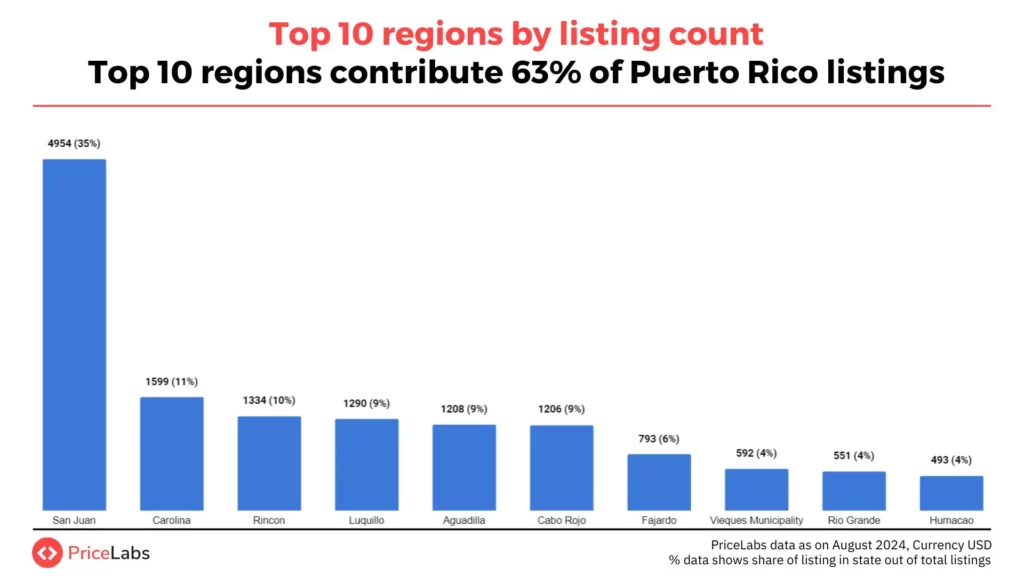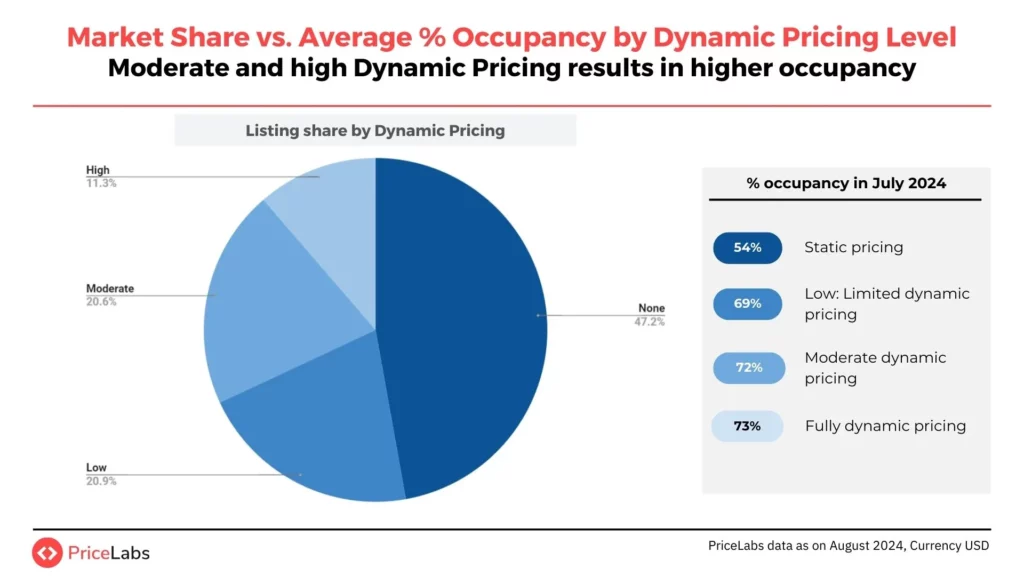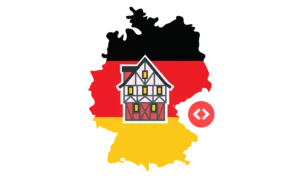Updated: October 29, 2024
According to a report commissioned by the Hispanic Federation, the number of units operating as short-term rentals in Puerto Rico jumped to over 25,000 in 2023 from about 1000 in 2014. Airbnb has generated more than $70 million in room tax revenues for Puerto Rico.
Puerto Rico – A Booming STR Market
The Puerto Rico short-term rentals market has shown growth and resilience, with an upward trajectory of 11% compared to last year. In 2020, the market had 11K listings, which has now doubled to 22 K. This growth can be attributed to various factors, including the aftermath of Hurricane Maria, which attracted many short-term rental investors to the island.


Bonus Read: The Best Airbnb Amenities to Boost Your Occupancy Rate, ADR, and RevPAR
Occupancy has been and is going to be stable
Despite an increase in the number of listings, key performance metrics remain stable. Comparing 2022-23 to 2023-24, the occupancy has remained stable. The average occupancy for the last year was 54%.




Listing Contribution by Region
Out of the 78 provinces in the Puerto Rico short-term rental market, the top 10 have a significant influence, contributing about 63% of the share of listings. They account for 13.5K listings out of the total 21.5K in the territory. San Juan leads the pack with 4954 listings.


Listing Contribution by Host Size
Small and individual hosts dominate the Puerto Rico short-term rental market. Small hosts have a market share of 49% with about 11K listings. Individuals run about 7K listings and make up about 32% of the market. Medium and large hosts comprise about 18% of the market share, with over 4k listings.


The Impact of Dynamic Pricing on Listings’ Performance
About 47.2% of listings do not use dynamic pricing. 21% of the listings in the market only use low dynamic pricing. Only 32% of the listings use high and/or moderate levels of dynamic pricing. Listings that use dynamic pricing saw an average of over 72% occupancy rate.


Impact of Dynamic Pricing on Occupancy
Listings with high dynamic pricing have an average occupancy rate of 65%. The listings that use moderate dynamic pricing have an average occupancy rate of 63%, and those that use low dynamic pricing only have a 59% occupancy rate. High dynamic pricing offers 20% higher occupancy than listings without dynamic pricing.


Main Challenges Faced by Short-term Rental Hosts in Puerto Rico
Short-term rental hosts in Puerto Rico face several challenges that impact their ability to operate effectively and profitably in a rapidly growing market. Here are the main challenges identified:
#1 Regulatory Environment
Hosts often navigate a complex regulatory landscape that varies by municipality. Compliance with local laws, including licensing and tax requirements, can be cumbersome and may deter potential hosts from entering the market. There is also ongoing debate about the impact of STRs on local housing markets, leading to potential restrictions or changes in regulations.
#2 Competition
The Puerto Rican STR market has seen a significant increase in listings, from about 1,000 in 2014 to over 25,000 in 2023. This surge has intensified competition among hosts, making it challenging for individual hosts and smaller property managers to maintain visibility and attract bookings. The concentration of listings in popular areas, particularly San Juan, further exacerbates this issue.
#3 Dynamic Pricing Adoption
While dynamic pricing can enhance revenue and occupancy rates, many hosts do not utilize this strategy effectively. Approximately 46% of listings do not employ dynamic pricing, which can lead to lower occupancy and revenue compared to those that do. Hosts unfamiliar with pricing strategies or lacking the tools to implement them may struggle to compete.
#4 Market Saturation
The rapid growth of the STR market has led to concerns about saturation, particularly in popular tourist destinations. To stand out in a crowded marketplace, hosts must differentiate their properties through unique offerings and high-quality service.
#5 Economic Factors
Economic fluctuations, including changes in tourism patterns and Puerto Rico’s overall economic health, can directly impact occupancy rates and revenue. Hosts must remain adaptable to shifts in demand, which can be influenced by external factors such as natural disasters or global events.
#6 Management and Operational Challenges
Many hosts, particularly individual owners, may lack the resources or expertise to manage their properties effectively. This includes challenges related to maintenance, guest communication, and marketing. Hosts who do not invest in professional management solutions may find optimizing their listings and maximizing their earnings difficult.
Key Insights
- The majority of listings are focused around San Juan.
- Revenue is stable across occupancy and RevPAR. The Future market will likely remain stable with some growth in the next 12 months.
- Small professional players have the largest share of listings, followed by individual owners.
- Most listings do not use Dynamic Pricing, and the ones that do have an average occupancy rate of 70%.
Choose PriceLabs to Stay Competitive in an Extremely Competitive Market
PriceLabs is a revenue management solution for the short-term rental and hospitality industry, founded in 2014 and headquartered in Chicago, IL. Our platform helps individual hosts and hospitality professionals optimize pricing and revenue management, adapting to changing market trends and occupancy levels.
Choose PriceLabs to increase revenue and streamline pricing and revenue management. Sign up for a free trial at pricelabs.co today.
- Dynamic Pricing Adjustments: PriceLabs continuously monitors market conditions and adjusts your listing prices in real time to maximize revenue and occupancy. This dynamic pricing strategy helps ensure that your rates remain competitive, which is essential for maintaining high booking volumes and meeting Airbnb’s hosting criteria.
- Customized Minimum Stay Requirements: PriceLabs allows you to set customized minimum stay requirements based on your preferences and market demand. By strategically adjusting minimum stay lengths, you can optimize your booking calendar, minimize gaps between reservations, and maximize your earning potential, all contributing to Superhost eligibility.
- Performance Analytics and Insights: PriceLabs provides detailed analytics and insights into your listing’s performance, including occupancy rates, revenue generated, and pricing trends. By monitoring these metrics, you can identify areas for improvement, adjust your pricing strategy accordingly, and maintain a competitive edge in the market, all of which are vital for Superhost recognition.
- Integration with Airbnb: PriceLabs seamlessly integrates with Airbnb, allowing you to manage your pricing strategy directly from the Airbnb platform. This integration streamlines the hosting process, saves time, and ensures consistency in pricing and availability across all your listings, contributing to a positive guest experience and, ultimately, Superhost status.
- Map listings across booking channels: PriceLabs makes it easy for you to make pricing adjustments and minimum night settings across booking channels.
- We integrate with 100+ property management systems and booking channels.









